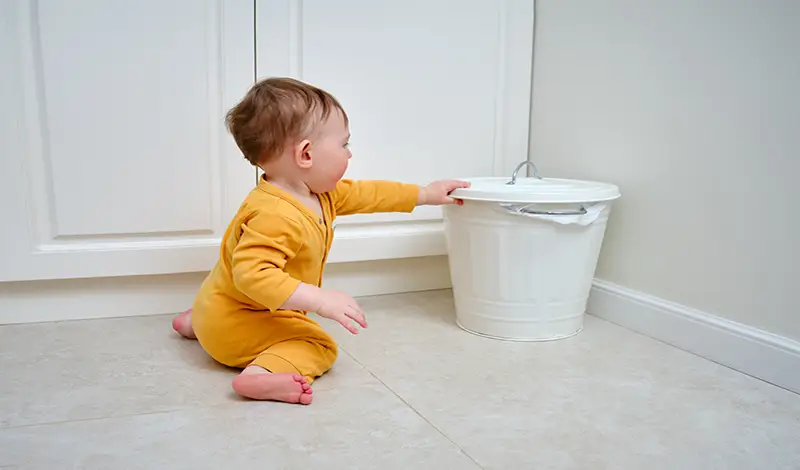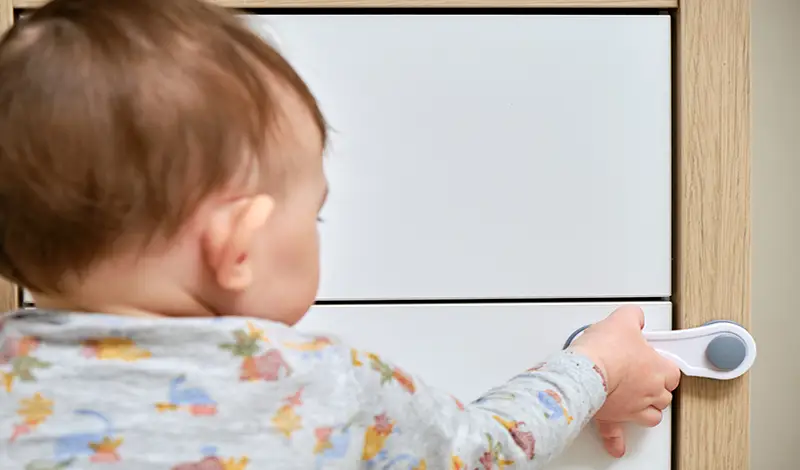How to Baby-Proof Your Home
Published on February 10, 2024 | 5 Minute read

Melanie
Ortiz Reyes
Content Specialist
Welcoming a new member to the family is an exciting and joyous occasion, but it also comes with a responsibility to ensure the safety and well-being of your little one. One of the crucial steps in preparing for a baby's arrival is baby-proofing your home. From curious fingers to wobbly first steps, it's vital to create a safe environment for your child to explore.

Conduct a Room-by-Room Safety Assessment
Start by conducting a thorough assessment of each room in your house. Identify potential hazards and make a list of areas that require attention. Consider the following factors:
- Electrical outlets: Install outlet covers or safety plugs to prevent little fingers from getting into sockets.
- Furniture stability: Anchor heavy furniture such as dressers and bookshelves to the wall to prevent tip-overs.
- Sharp edges: Use corner guards to cushion sharp edges on tables, countertops, and furniture.
- Window cords: Secure window cords out of reach or use cordless window coverings to prevent strangulation.
- Doors: Install doorstops to prevent little fingers from getting pinched, and consider adding finger pinch guards to doors.
Secure Furniture and Appliances
Babies are naturally curious and love to explore their surroundings. To prevent accidents, secure furniture and appliances that could pose a threat. Use furniture straps to anchor heavy items like dressers, bookshelves, and TVs to the wall. Consider installing safety latches on cabinets and drawers to keep your baby from accessing potentially harmful items such as cleaning supplies or sharp objects.
Install Safety Gates
Safety gates are essential tools to restrict your baby's access to certain areas of your home. Use gates at the top and bottom of staircases to prevent falls. Also, consider using gates to block off rooms that haven't been fully baby-proofed or to keep your little one out of the kitchen while you're cooking.
Baby-Proof the Kitchen
The kitchen can be a potential minefield for curious toddlers. Take the following steps to baby-proof this high-traffic area:
- Cabinet locks: Install cabinet locks to keep little hands away from cleaning supplies, sharp objects, and potentially harmful chemicals.
- Appliance safety: Use appliance locks to secure ovens, refrigerators, and dishwashers.
- Stove guards: Install stove guards to prevent your child from reaching hot burners or grabbing pot handles.
Secure Windows and Blinds
Windows and blinds pose unique risks for curious babies. Follow these steps to minimize hazards:
- Window guards: Install window guards to prevent falls.
- Cordless blinds: Opt for cordless window coverings to eliminate the risk of strangulation from cords.
- Cords: Tie up or cut blind cords that are within reach.

Eliminate Small Choking Hazards
Babies explore the world by putting things in their mouths, so it's crucial to remove small objects that could pose a choking hazard. Regularly scan your home for small items like coins, buttons, or small toys and keep them out of your baby's reach.
Soften the Landing
As your baby starts to crawl and take their first steps, it's important to create a soft landing for those inevitable tumbles. Consider these tips:
- Use rugs with non-slip pads to prevent slips and falls.
- Place soft, cushioned mats in play areas to protect against bumps and bruises.
- Consider installing corner guards on coffee tables and other low furniture to minimize the impact of collisions.
Secure Electronics and Cords
Electronic devices and cords can be intriguing to babies but pose serious risks. Take these steps to baby-proof your electronics:
- Use outlet covers to prevent access to electrical outlets.
- Secure cords out of reach or use cord organizers to minimize the risk of strangulation.
- Consider investing in cordless electronic devices to eliminate cords altogether.
Create a Safe Sleep Environment
A safe sleep environment is crucial for your baby's well-being. Follow these guidelines:
- Use a crib that meets safety standards with a firm mattress and fitted sheets.
- Remove soft bedding, stuffed animals, and pillows from the crib to reduce the risk of suffocation.
- Position your baby on their back to sleep to reduce the risk of Sudden Infant Death Syndrome (SIDS).

Be Mindful of Small Objects
Babies are naturally curious and love to explore with their hands and mouths. Keep small objects out of their reach to avoid choking hazards. Be especially vigilant about small items like buttons, coins, and small toys that can easily fit into a baby's mouth.
Baby-proofing your home is an ongoing process that evolves as your child grows and explores new areas. Regularly reassess and update safety measures to ensure your home remains a secure haven for your little one. By taking these proactive steps, you'll create an environment that nurtures your baby's curiosity while prioritizing their safety and well-being. Remember, each baby is unique, so tailor your baby-proofing efforts to suit your child's specific needs and developmental milestones. Parenthood is an exciting journey, and with a well-prepared and baby-proofed home, you can navigate it with confidence and peace of mind.